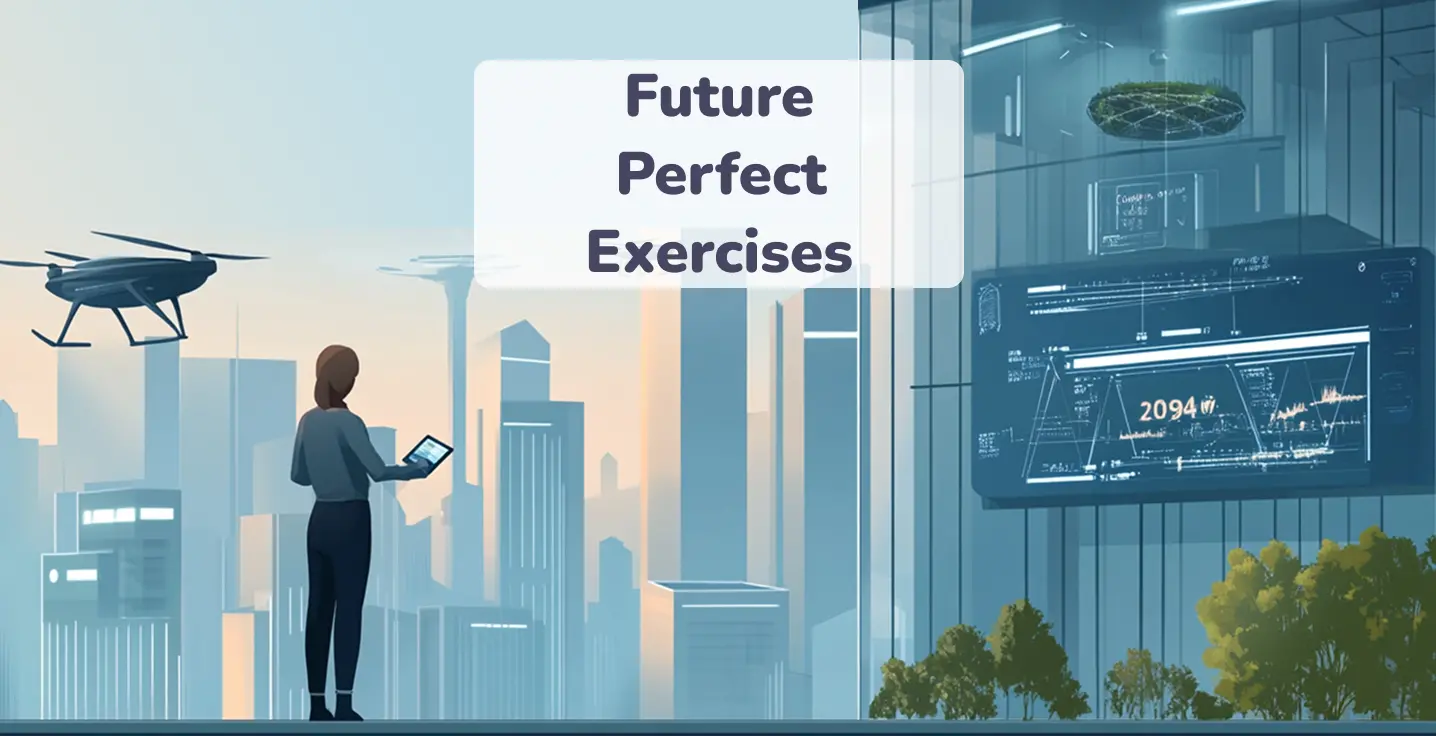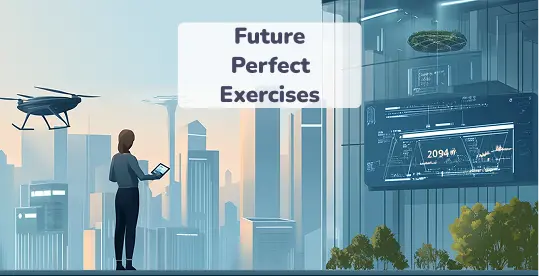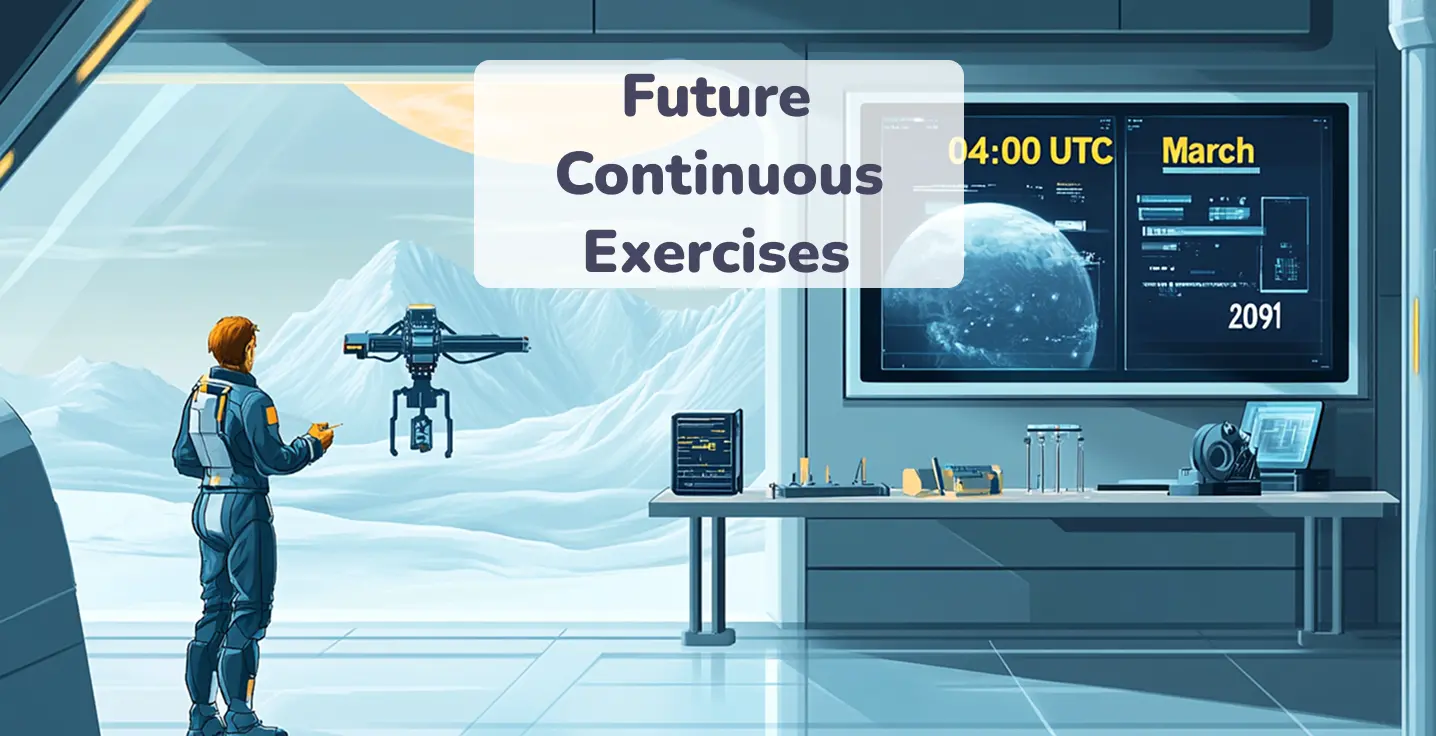Future Perfect exercises
What are the best Future Perfect tense exercises?
The practices in the Future Perfect tense let you speak like a fortune teller with a checklist: By then, this will have happened. To get there, regular practice beats cramming every time. Here’s how to space out your best exercises for success:
| Exercise type | Focus area | Why it’s effective | Example |
|---|---|---|---|
|
Fill-in-the-gap drills |
Sentence formation |
Reinforces word order and helps internalize the tense structure |
By noon, she ___ (submit) the report. will have submitted |
|
Mistake hunt |
Error spotting |
Trains your eye to recognize and fix frequent Future Perfect errors |
Before: He will have eats. After: He |
|
Timeline sort |
Event sequencing |
Builds awareness of completed actions in relation to future points |
Sort: 5 PM They
|
|
Story starters |
Creative writing |
Encourages original use of Future Perfect in a meaningful context |
Begin: “In two weeks, I |
|
Match the sentence |
Visual & logic reasoning |
Strengthens connections between time expressions and correct tense usage |
Match: By the weekend He
|
|
Quiz with options |
Comprehension check |
Offers fast, varied grammar checks with self-correction opportunities |
She ___ the task before dinner. A) finishes |
How to avoid common mistakes in Future Perfect practice?
Getting the hang of the Future Perfect tense isn’t rocket science, but there are a few traps that even advanced learners step into. Let’s iron out the most common wrinkles before they slow your progress.
-
Mixing up verb forms. The biggest pitfall? Using the wrong past participle. Learners often write will have went instead of will have gone. Stick to the formula: will have + past participle — not Simple Past, not base form.
By then, I will have wrote three chapters.By then, I will have written three chapters.Tip: If it sounds like something you’d shout in a pirate movie, it’s probably wrong.
-
Skipping the will. Will can’t be skipped, even if some learners think otherwise. In the Future Perfect tense, will have is the engine that drives the sentence forward in time. Without will the sentence no longer expresses a future action and becomes incomplete.
She have finished her shift by 6.She will have finished her shift by 6.Tip: Imagine will as your boarding pass to the future. Skip it in Future Perfect tense exercises, and your sentence misses the flight.
-
Forgetting the future time reference. The Future Perfect always ties an action to a specific point in the future. If there’s no phrase like by next month or before Friday, the sentence loses its edge.
We will have packed our bags.We will have packed our bags before the taxi arrives.Tip: Plant your timeline as the Future Perfect needs a destination in time to land properly. Without a future time marker, it’s like a race with no finish line.
-
Overcomplicating the structure. Some students treat Future Perfect activities like a grammar puzzle, stacking unnecessary parts just to feel complete. But the tense works best when it’s smooth and straightforward. If your sentence takes a detour, bring it back on track.
You will have already been having made the reservation by then.You will have already made the reservation by then.Tip: Clarity wins — keep the sentence tidy, and the tense shines.
-
Using Future Perfect when it’s not needed. The Future Perfect tense isn’t a fancy upgrade — it has a specific job: to show that an action will be completed before a certain moment in the future. If there’s no clear future event to compare it to, the sentence sounds awkward or forced.
He will have started his new job next Monday.He will have started his new job before the training begins.Tip: Use Future Perfect only when something is done before a clear future moment. If there’s no finish line, go for simple Future (will + base verb) instead.
How often should you take a Future Perfect tense test?
Consistent practice with repetitions builds confidence. Here’s a handy table to help you decide when and why to test your skills — and how to make it count.
| Frequency | Why it’s useful | Pro tip |
|---|---|---|
|
Every Monday |
Keeps grammar sharp like clockwork |
Take a quick quiz over breakfast |
|
After writing tasks |
Reinforces usage in real contexts |
Test with sentences from your own writing |
|
Before a deadline |
Ensures you’re exam-ready |
Use full-length, timed practice tests |
|
Mid-topic check-in |
Catches errors before they stick |
Focus on trickier time references |
|
Monthly review |
Tracks long-term progress |
Compare your last 3 test scores |
Can Future Perfect activities improve your writing skills?
Absolutely. Perfect Future tense exercises polish your grasp of a tricky grammar form and sharpen your writing’s precision and clarity. Practicing how to describe actions completed by a future moment trains your brain to think ahead, organize timelines clearly, and express cause-and-effect relationships smoothly.
This ability results in more compelling arguments and more fluid storytelling. Your writing gains a confident flow and demonstrates a solid command over time and sequence in place of ambiguous or uncomfortable terminology. Plus, becoming proficient in the Future Perfect while learning English aids in avoiding typical mistakes like uncertain verb tenses, which can divert or perplex readers.
Engaging in Perfect Future exercises on a regular basis improves your writing skills, particularly when predicting, planning, or making predictions. To put it briefly, these workouts enhance your writing, just the way a stylish turbocharger would enrich your language skills.
What makes a great Future Perfect quiz for self-study?
A well-designed Future Perfect tense worksheet challenges your understanding of time sequencing and how grammar fits naturally into real contexts. For effective self-study, it should include:
- Variety keeps you engaged.
Good quizzes mix different question types — filling in blanks, fixing mistakes, and finishing short stories. This variety helps your brain stay alert and see the Future Perfect tense in many ways.
- Real-life examples make it stick.
Using sentences like “When you get here, I
will have watered the plants” connects grammar to everyday moments. When you imagine yourself talking about plans or special occasions, the tense feels natural and easy to use. - Getting quick feedback matters.
Knowing why an answer is right or wrong helps you remember better next time. It’s like having a coach who points out the small details that make all the difference, like spotting when to use Future Perfect instead of Future Simple.
- Progressive difficulty levels.
Start simple, then increase complexity with compound sentences and time clauses during Future Perfect activities. It builds your skill gradually without overwhelming you.
Great quizzes at Koto English feel like a conversation with your future fluent self. They are clear, helpful, and motivate you to keep improving.
What to study after completing the Future Perfect test?
Completing a test or exercises Future Perfect allows for greater mastery and deeper learning. Turn what you discovered into a plan; that’s how real progress happens, one step at a time. We would like to suggest a straightforward, step-by-step strategy to follow after your test:
-
Check mistakes and write them down. Identify where you slipped up. Writing down errors helps you remember and avoid repeating them.
-
Review the theory on difficult topics. Go back to tricky points, like when to use Future Perfect vs. other future tenses, and clarify any confusion.
-
Do some additional assignments. Practice those weak spots with a targeted Future Perfect tense worksheet. Repetition builds confidence and sharpens skills.
-
Use the tense in writing or speaking. Put theory into practice by writing sentences, short paragraphs, or talking about your plans using Future Perfect.
By taking these actions, you may transform an exam into an effective teaching tool that will solidify your understanding of the Future Perfect tense and prepare you for practical applications.





